|

|
Odorheiu Secuiesc
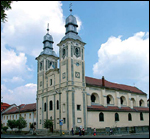 The history of the town Odorheiu Secuiesc is woven around the legends of Csicser, Budvár, Szekler-attacked castle and the hill of Saint Miklós. The most ancient legend has the castle Budvár, whitch was built – according to the legend – by Buda, the brother of the Hun king, Attila, and was ruined by Tartars in 1241. Csicser with its ruin of a small post-castle on the top is situated near Budvár. In the center of the town you find the remains of the castle Szekler-attacked, which was a monastery long time ago. In 1562, by the time of János Zsigmond the Szekler nation rose up, but the rebel ended in failure. This event is the origine of the name of the castle. Between the sights of the town is important the Romanesque style chapel of Jesus, the Franciscan church and monastery with two tower, the Roman-Catholic church on the Saint Miklós hill, and the decorative element of the whole town, the Tamási Áron high school. The history of the town Odorheiu Secuiesc is woven around the legends of Csicser, Budvár, Szekler-attacked castle and the hill of Saint Miklós. The most ancient legend has the castle Budvár, whitch was built – according to the legend – by Buda, the brother of the Hun king, Attila, and was ruined by Tartars in 1241. Csicser with its ruin of a small post-castle on the top is situated near Budvár. In the center of the town you find the remains of the castle Szekler-attacked, which was a monastery long time ago. In 1562, by the time of János Zsigmond the Szekler nation rose up, but the rebel ended in failure. This event is the origine of the name of the castle. Between the sights of the town is important the Romanesque style chapel of Jesus, the Franciscan church and monastery with two tower, the Roman-Catholic church on the Saint Miklós hill, and the decorative element of the whole town, the Tamási Áron high school. |
The Red Lake
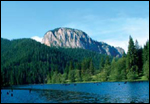 In the middle of the Eastern Carpathians visitors can discover the legendary blockage-lake, the Red Lake. The Bicaz streamlet cuts through the Hăşmaş mountains, its gurgling and the cliff rock faces that are accompaying will be an unforgetabble experience for the visitor. In the middle of the Eastern Carpathians visitors can discover the legendary blockage-lake, the Red Lake. The Bicaz streamlet cuts through the Hăşmaş mountains, its gurgling and the cliff rock faces that are accompaying will be an unforgetabble experience for the visitor.
|
Saint Ana’s Lake
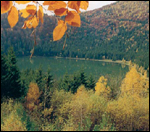 “Like the water in the bottom of a huge platter, lies Saint Ana’s Lake in the bottom of sky-high mountains. Is surrounded by mountains with wreath of pine-groves. You can walk across every region, but you will not find a more beautiful look like this is.” (Benedek Elek) It is the only undamaged volcanic crater-lake in SouthEast Europe, and it is a result of a strong volcanic activity, related to the formation of the Carpathians. Its fauna is poor because of the law quantity of mineral substance; the crater is 950 m deep. The thick mud stratum is a sign of bank up. Its twin-crater, the Mohos is aged, the water is on the ebb step by step for thousand years on end, became marshy, and it is known as alpine bog peat. “Like the water in the bottom of a huge platter, lies Saint Ana’s Lake in the bottom of sky-high mountains. Is surrounded by mountains with wreath of pine-groves. You can walk across every region, but you will not find a more beautiful look like this is.” (Benedek Elek) It is the only undamaged volcanic crater-lake in SouthEast Europe, and it is a result of a strong volcanic activity, related to the formation of the Carpathians. Its fauna is poor because of the law quantity of mineral substance; the crater is 950 m deep. The thick mud stratum is a sign of bank up. Its twin-crater, the Mohos is aged, the water is on the ebb step by step for thousand years on end, became marshy, and it is known as alpine bog peat.
|
Sumuleu Ciuc
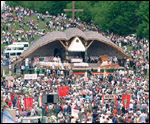 The Baroque cathedral of Şumuleu, as ancient pilgrim place to St. Maria, attracts nations and generations with its greatness, beauty and miraculous power. The pilgrims of Whitsuntide are organized from 1567, after the winner battle from Tolvajos, in memory of that, because that was the moment when Roman-Catholics from Ciuc and Gheorheni zone averted the peril of aggressive missionary work from their native county. The Rennaisance statue of the Woman dressed in Sun is in the center of the pilgrims. The Baroque cathedral of Şumuleu, as ancient pilgrim place to St. Maria, attracts nations and generations with its greatness, beauty and miraculous power. The pilgrims of Whitsuntide are organized from 1567, after the winner battle from Tolvajos, in memory of that, because that was the moment when Roman-Catholics from Ciuc and Gheorheni zone averted the peril of aggressive missionary work from their native county. The Rennaisance statue of the Woman dressed in Sun is in the center of the pilgrims.
|
Sovata Băi
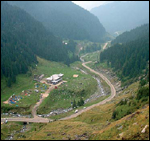 In historical documents is written that that already in the time of Romans people was diggind up the salt and they knew the curative effect of the salted water. In Sovata there are salt lakes in the places of ancient salt mines, and in caves created by rivers which dissolved the salt. The region is specific by the glittering water surfaces. The most well known lake is the Bear-lake, the shape of the lake gives its name - a sperad uut bearskin, and it lies below the Cseresznyés Mountain. The water of the lake is extremely salted, heliotermic, and it is well known for its curative effect of rheumatic and gynecological illnesses. In historical documents is written that that already in the time of Romans people was diggind up the salt and they knew the curative effect of the salted water. In Sovata there are salt lakes in the places of ancient salt mines, and in caves created by rivers which dissolved the salt. The region is specific by the glittering water surfaces. The most well known lake is the Bear-lake, the shape of the lake gives its name - a sperad uut bearskin, and it lies below the Cseresznyés Mountain. The water of the lake is extremely salted, heliotermic, and it is well known for its curative effect of rheumatic and gynecological illnesses.
|
Făgăras Mountains
 As Babits Mihály, the poet who lived in Făgăras, said about the violet shadows of the diamond snow-covered mountains of the South-Carpathians: As Babits Mihály, the poet who lived in Făgăras, said about the violet shadows of the diamond snow-covered mountains of the South-Carpathians:
“Mountains like clouds,
Clouds like mountains,
Where the fog assumes body,
And the stone hovers up,
And almost describeable,
Almost imagineable
The veiled sunbeam
Gleams on the peak.”
The “Alps of Transilvania” is the most popular center of alpine tourism. Its rock faces and side-crests offer many rock-climbing routes. The visitors must have adequate clothing and equipment to the apline weather condition. Glittering lakes sheltered behind glacier stairs are the bright spot of the mountains.
|
|
|
|